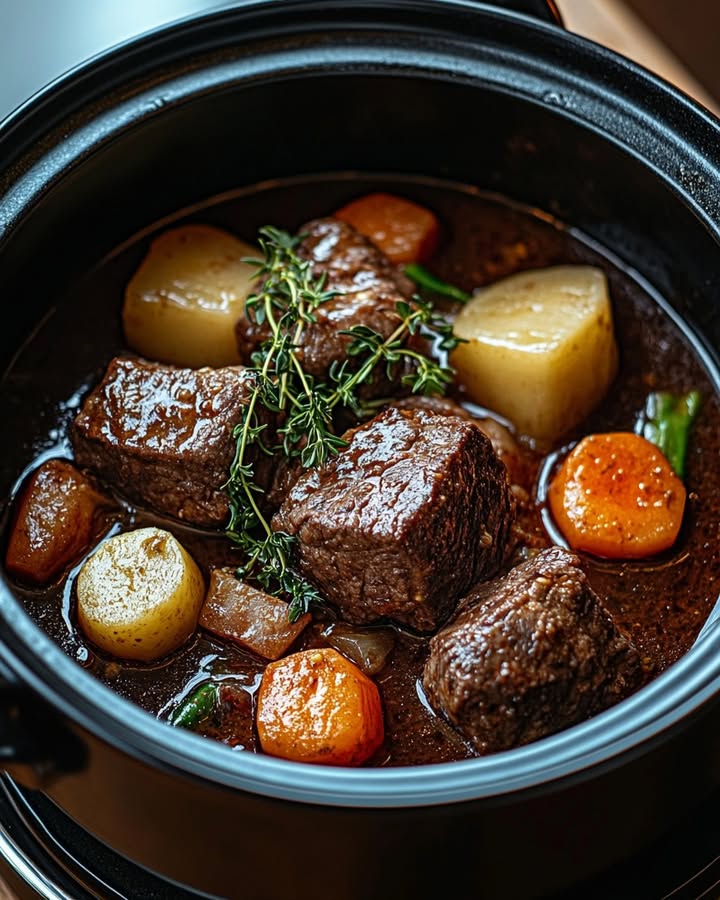A Hearty Tuscan Beef Stew to Warm Your Soul
There’s something magical about a slow-cooked stew that fills the house with mouthwatering aromas. I remember the first time I made this Tuscan Beef Stew. It was a chilly winter evening, and my family had just come in from sledding. The moment they walked through the door, their eyes lit up—no words needed. That’s the power of this dish: it’s comforting, flavorful, and perfect for bringing people together. Whether you’re cooking for your loved ones or hosting a cozy dinner party, this recipe will impress without breaking a sweat.
The Roots of Tuscan Beef Stew
This hearty dish hails from Tuscany, a region in Italy known for its rustic and soul-satisfying cuisine. Traditionally, Tuscan Beef Stew was a way to make tough cuts of meat tender and flavorful by slow-cooking them with simple ingredients like tomatoes, herbs, and wine. Over time, variations emerged, but the essence remains the same: rich flavors developed over hours of gentle simmering. I love how this recipe bridges generations—it’s as much at home on a modern table as it would have been centuries ago in an Italian farmhouse.
Why You’ll Fall in Love with This Recipe
If you’re looking for a dish that’s big on flavor but low on fuss, this is it. The combination of tender beef, sweet carrots, savory onions, and aromatic herbs creates layers of taste that are simply irresistible. Plus, the slow-cooking process does all the hard work for you. One bite, and you’ll understand why this stew has been a favorite for so long. Trust me, once you try it, it’ll become a staple in your kitchen.
Perfect Occasions for Tuscan Beef Stew
This stew shines during colder months when everyone craves something warm and hearty. It’s ideal for family dinners, holiday gatherings, or even meal prep Sundays. Imagine serving it on a snowy evening, paired with crusty bread or creamy polenta. Or picture it as the star of your Sunday supper, leaving your guests asking for seconds (and the recipe). Honestly, any occasion becomes special with this dish on the menu.
Ingredients You’ll Need
- 3 lb (1.4 kg) beef chuck roast, cut into large chunks
- Salt and pepper to taste
- 2 tablespoons extra virgin olive oil
- 1 cup finely chopped onion
- 1 cup diced carrots
- 1 cup diced celery
- 2 cloves garlic, thinly sliced
- ½ teaspoon red pepper flakes (optional)
- 1 cup dry red wine
- 2 cups beef broth
- 1 can (14.5 oz) crushed tomatoes
- 1 tablespoon tomato paste
- 1 sprig fresh thyme or 1 teaspoon dried thyme
- 1 sprig fresh rosemary or 1 teaspoon dried rosemary
- 2 bay leaves
- 1 teaspoon dried oregano
- 1 tablespoon balsamic vinegar
Substitution Options
Not everyone has access to the exact ingredients listed, and that’s okay! If you don’t have fresh herbs, dried ones work just fine. Swap out beef broth for chicken broth if needed, though the flavor won’t be quite as robust. For those avoiding alcohol, replace the red wine with additional broth mixed with a splash of grape juice for sweetness. And if you’re vegetarian, try using mushrooms instead of beef—they soak up the sauce beautifully.
Step 1: Preparing the Meat
Start by seasoning your beef generously with salt and pepper. Heat the olive oil in a large pot over medium-high heat until shimmering. Add the beef chunks, making sure not to overcrowd the pan—this ensures a nice sear. Cook each side for about 4-5 minutes until golden brown. The sizzle and aroma at this stage are incredible, setting the tone for what’s to come. Once done, remove the meat and set it aside.
Pro tip: Pat the beef dry with paper towels before searing. Moisture is the enemy of browning!
Step 2: Cooking the Vegetables
In the same pot, add the onions, carrots, and celery. These veggies form the base of our stew, adding natural sweetness and depth. Stir occasionally until they soften, which takes about 8 minutes. Then toss in the garlic and red pepper flakes, letting them cook for another minute. The fragrance alone will make your kitchen feel like a five-star restaurant.
Pro tip: Don’t rush this step—the caramelization of the vegetables builds flavor.
Step 3: Deglazing with Wine
Pour in the red wine, scraping the bottom of the pot to release those delicious browned bits. This is called deglazing, and it’s key to unlocking maximum flavor. Let the liquid reduce by half, which should take around 5 minutes. Watch as the wine transforms into a syrupy glaze, hinting at the richness ahead.
Chef’s tip: Use a bold red wine like Chianti for authentic Tuscan vibes.
Step 4: Adding Aromatics and Simmering
Now it’s time to bring everything together. Stir in the beef broth, crushed tomatoes, tomato paste, herbs, and bay leaves. Return the beef to the pot, cover, and let it simmer gently for 3-4 hours. Alternatively, transfer it to the oven at 275°F (140°C) or use a slow cooker. As the stew cooks, the kitchen fills with a heavenly scent that’s impossible to resist.
Pro tip: Taste and adjust seasoning halfway through cooking for balanced flavors.
Step 5: Final Touches and Serving
Once the beef is fork-tender, stir in the balsamic vinegar to brighten the flavors. Remove the herb stems and bay leaves before serving. Ladle the stew into bowls alongside pasta, polenta, or mashed potatoes. Top with grated Parmesan for an extra layer of indulgence. Every spoonful is pure comfort.
Timing Breakdown
- Prep Time: 20 minutes
- Cooking Time: 3-4 hours (stovetop), 8-10 hours (slow cooker)
- Total Time: Approximately 3.5-4.5 hours
Chef’s Secret
For a deeper umami kick, add a handful of rehydrated dried porcini mushrooms to the stew. They infuse the sauce with earthy tones that elevate the entire dish. It’s a trick I learned from my grandmother, and it never fails to impress.
An Interesting Tidbit
Did you know that Tuscans often refer to this type of stew as “stracotto”? The word means “overcooked,” highlighting the importance of slow, patient cooking. While the term might sound odd, the result is anything but!
Necessary Equipment
- Large heavy-bottomed pot or Dutch oven
- Wooden spoon for stirring
- Sharp knife for chopping vegetables
- Measuring cups and spoons
Storage Tips
This stew keeps beautifully in the fridge for up to 4 days. Store it in an airtight container to preserve freshness. Reheat gently on the stovetop or microwave, adding a splash of broth if it thickens too much. Freezing is also an option; portion it into smaller containers for easy reheating later.
When freezing, label the containers with the date to keep track of freshness. Thaw overnight in the fridge before reheating. Proper storage ensures you can enjoy this dish anytime, even on busy weeknights.
Tips and Advice
- Brown the meat thoroughly—it adds immense flavor.
- Don’t skip the balsamic vinegar; it ties all the flavors together.
- If using a slow cooker, sear the meat and sauté the veggies first for best results.
Presentation Ideas
- Serve in shallow bowls with a dollop of mascarpone cheese.
- Garnish with fresh parsley or basil for a pop of color.
- Pair with crusty bread or garlic knots for dipping.
Healthier Alternatives
For a lighter version, consider these swaps:
- Use leaner cuts of beef or substitute with turkey thighs.
- Replace some of the beef broth with vegetable broth for fewer calories.
- Add more veggies like zucchini or bell peppers for added nutrients.
- Omit the balsamic vinegar or use a sugar-free alternative.
- Try serving over cauliflower mash instead of potatoes.
- Reduce the amount of oil used for searing.
Common Mistakes to Avoid
Mistake 1: Skipping the Searing Step
Some folks skip browning the meat to save time, but this step is crucial. Searing locks in juices and creates a flavorful crust. Without it, your stew may lack depth. Always take the extra few minutes—it’s worth it.
Mistake 2: Overcrowding the Pot
When searing meat or sautéing veggies, give them space. Crowded pots lead to steaming rather than browning, resulting in dull flavors. Cook in batches if necessary.
Mistake 3: Rushing the Simmer
Patience is key here. Slow cooking allows the beef to become melt-in-your-mouth tender. Turning up the heat won’t speed things up—it’ll only ruin the texture.
FAQ Section
Can I Make This Recipe Ahead?
Absolutely! In fact, many stews taste better the next day as the flavors meld further. Just cool completely before refrigerating.
What Kind of Wine Should I Use?
Choose a full-bodied red wine like Merlot or Cabernet Sauvignon. Avoid cooking wines—they tend to be overly salty and lack complexity.
Is This Dish Gluten-Free?
Yes, as long as you ensure the beef broth and other packaged ingredients are gluten-free. Double-check labels to be safe.
Can I Use Frozen Vegetables?
While fresh veggies provide the best texture, frozen ones can work in a pinch. Add them towards the end of cooking to prevent mushiness.
How Do I Know When the Beef Is Done?
The beef should easily shred with a fork. If it feels tough, let it cook longer.
Can I Double the Recipe?
Definitely! Just make sure your pot is large enough to accommodate the increased volume.
What Can I Serve With This Stew?
Polenta, mashed potatoes, or egg noodles pair wonderfully. For a low-carb option, try roasted vegetables or a crisp salad.
Should I Trim the Fat from the Beef?
Trimming excess fat is optional. Leaving a bit on helps keep the meat moist during cooking.
Can I Add Beans to the Stew?
Yes! Cannellini beans or chickpeas complement the flavors nicely while adding protein and fiber.
How Long Does It Last in the Freezer?
Properly stored, this stew can last up to 3 months in the freezer. Beyond that, quality may decline.
Final Thoughts
This Tuscan Beef Stew is more than just a recipe—it’s a celebration of slow food and shared meals. Whether you’re feeding your family or hosting friends, it’s bound to leave a lasting impression. So grab your apron, pour yourself a glass of wine, and get ready to create something truly unforgettable. Buon appetito!

Tuscan Beef Stew
Ingredients
Equipment
Method
- Season beef generously with salt and pepper; heat olive oil in a large pot over medium-high heat.
- Sear beef chunks in batches for 4-5 minutes on each side until golden brown; remove and set aside.
- Add onions, carrots, and celery to the pot; cook, stirring occasionally, until softened, about 8 minutes.
- Stir in garlic and red pepper flakes; cook for an additional minute.
- Pour in red wine and deglaze the pot, scraping brown bits from the bottom; reduce wine by half, about 5 minutes.
- Stir in beef broth, crushed tomatoes, tomato paste, herbs, and bay leaves; return beef to pot, cover, and simmer for 3-4 hours or transfer to oven at 275°F (140°C).
- After cooking, stir in balsamic vinegar; remove herb stems and bay leaves before serving.
- Ladle into bowls and serve with pasta, polenta, or mashed potatoes. Top with grated Parmesan if desired.
